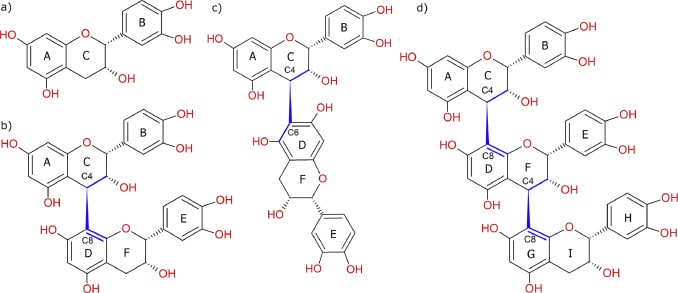Find a download of the entire article here.

We’re proud to share our latest publication, in collaboration with the Centre of Molecular and Macromolecular Studies and Wroclaw Medical University. Marta Dudek did exceptional work modeling and determining structural properties of oligomeric proanthocyanidins (PACs), furthering our understanding of their behaviors.
If you would like to purchase the oligomeric proanthocyanidins, or other procyanidin reference standards, you can explore our catalog with the following links. If you don’t see what you are looking for, please reach out to us. If you are an academic group doing research, please contact us and we will discuss opportunities for collaboration and support.
Abstract
Proanthocyanidins (OPACs) are the second largest class of plant metabolites after lignans. Although knowledge of their 3D conformations would add greatly to our understanding of their biological properties, very little has been published on the conformations of OPACs with a degree of polymerization (DP) above 4. We investigated the conformations of the linear epicatechin oligomers, prominent representatives of OPACs prevalent in apples and cocoa, where the epicatechin units are interconnected through the 4β-8 bonds. For DP-2 to DP-10 oligomers, conformational preferences reflected in the arrangement of consecutive flavan-3-ol units, are characterized by the φ torsion. For dimers, there are two energy wells corresponding to two preferred φ torsions, designated as compact and extended form. This behaviour is preserved in OPACs with higher DPs, but the most energetically favoured conformations are a combination of both, with compact-only or extended-only conformations being very unlikely. Thus, oligomers with DP ≥ 7 tend to assume an overall conformation approximating a spherical shape. This shape has a significant influence on the polarity of the OPAC oligomers expressed as 3D polar surface area, calculated using Spartan software for geometry-optimized 3D models, and possibly on other physicochemical properties. The results of polarity calculations provide a molecular-level rationale for the polarity-based chromatographic separation of the cocoa B-type procyanidins with DP range 4 to 10. In our experiments, using centrifugal partition chromatography (CPC) (a solvent system consisting of EtOAc-EtOH-water (6:1:5) v/v/v with aqueous phase stationary and upper phase mobile) we found that an enriched mixture of proanthocyanidins eluted first DP-1 (epicatechin) followed by consecutive elution of the DP-2 to DP-10 in the linear 4β-8 form. We demonstrated that such separation would not be possible if compact-only or extended-only conformations were present in solution. However, for the energy-favoured, spherically shaped conformations, the observed CPC elution order is fully justified.


